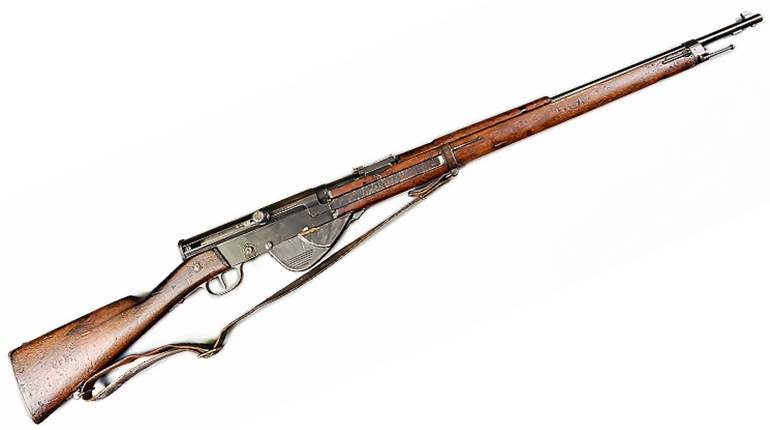
This article, "The Last Of Its Kind: FN's Model 1949 Self-Loading Rifle", appeared originally in the December 2005 issue of American Rifleman. To subscribe to the magazine, visit the NRA membership page here and select American Rifleman as your member magazine.
Made in the traditional manner using machined steel forgings and a wood stock, the Fabrique Nationale (FN) Model 1949 self-loading rifle was one of the last elegant, old-world military rifles. Arguably the best self-loading rifle design of its era, production was delayed first by World War II and, later, by post-war events. By the time the FN-49—also known as the SAFN (Semi-Automatique Fabrique Nationale)—finally entered production in 1949, it was already becoming obsolete and was soon overtaken by a later generation of military rifles.
Founded in 1889 to build military rifles for the Belgian army, FN started producing Model 1889 Mausers for Belgium in 1891. It soon expanded its Mauser line with the Model 1893 that was exported to Brazil and Costa Rica among other countries. In 1896, Germany’s Ludwig Loewe consortium bought majority ownership in FN to restrict its Mauser exports.In order to survive, FN’s management diversified and expanded into sporting arms, bicycles, motorcycles and automobiles. A chance meeting with John Browning in 1897 literally saved the firm. Soon after, FN produced Browning’s first pistol, the Model 1899. Through the years, FN produced many other Browning designs, and the conclusion of the Great War ended German majority stock ownership.

The Belgian firm’s efforts to develop a military self-loading rifle began with the little-known Model 1914 experimental rifle, but work on the design was not continued after the war. Nearly 20 years passed before FN resumed development of a military self-loader. Dieudonne Saive, who became FN’s chief firearms designer after the death of John Browning, worked on several short-recoil-operated rifle designs between 1932 and 1934.
Abandoning recoil-operation, Saive developed and patented a new gas-operated rifle in 1936, and a prototype was built the following year. Photographs show the basic characteristics that would be used in the final FN-49 design: a bolt carrier-actuated, rear-locking, tilting bolt and a gas system with a full-length piston to drive the bolt carrier. Before it could be refined, World War II would intervene.
Germany invaded Belgium in May 1940 and soon overran Liege, home of the FN factory. Saive concealed his self-loading rifle design from the Germans, and in the summer of 1941, he was able to make his way to Spain and then England, where he continued development of the rifle. In the latter part of 1943, 50 prototype self-loading rifles were ordered by Enfield.
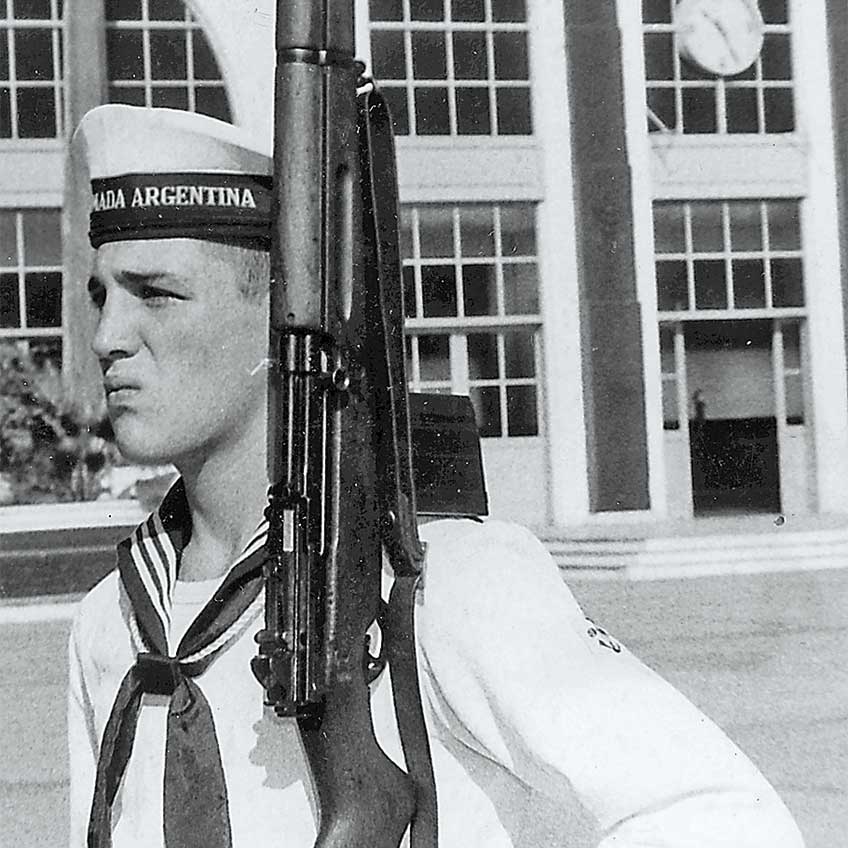
Completed in early 1944, the prototypes were designated “EXP-1,” sometimes referred to as the SLEM (Self-Loading Experimental Model). After testing, several design changes were requested, and an order was placed with Enfield for 2,000 rifles to be used for troop trials. Meanwhile, Saive, who had returned to Belgium as soon as Liege was liberated in September 1944, continued to finalize the design. A last-minute issue with the gas system delayed completion, and with the end of the war in sight, the British cancelled the order.
Saive continued to work on the rifle, and by the end of 1947, it was finally ready for production. The result was a full-size infantry rifle weighing about 9½ lbs. Most of the exterior metal parts were finished with black enamel paint applied over a phosphate coating. The stock was walnut with a traditional linseed oil finish.
Standard features included an adjustable gas system with the ability to turn off the gas (for grenade launching), a hammer-cocking indicator, and a dust cover that sealed the action from debris. Offsetting the gun’s better features was its use of a stripper-clip-loaded, semi-fixed, 10-round magazine—unusual considering the post-war trend toward the use of detachable magazines.

In March 1948, the first production order was received from a long-standing FN customer: Venezuela. Before production ended, FN-49 rifles would be sold to at least 26 nations. Most orders were for small quantities of trials rifles, but nine nations placed production orders.
Following Venezuela, production orders came from Egypt, Belgium, Luxembourg, Indonesia, the Belgian Congo, Colombia, Argentina and Brazil. The rifle was in production from 1949 until 1956. After a five-year hiatus, a final order was delivered to Indonesia in 1961. In total, more than 176,000 FN-49s were produced.
The FN-49 was chambered for seven different cartridges. Five rifles chambered for 6.5x55 mm were sold to Sweden, a single rifle in 7.5x54 mm was sold to Syria, and a single rifle in 7.62x51 mm NATO was sold to Brazil. Four chamberings were used in both trials rifles and for the nine production contracts. Selecting the .30-’06 Sprg. chambering were Belgium, the Belgian Congo, Brazil, Colombia, Indonesia and Luxembourg; Argentina selected the 7.65 mm Mauser; Egypt, the 7.92 mm Mauser; and Venezuela, the 7 mm Mauser. Argentina would later modify its rifles to chamber the 7.62x51 mm cartridge, making a total of five chamberings that were used in significant quantities.

Saive had a reputation for continually refining his designs to improve function and reliability, and the FN-49 was no exception. Numerous changes were phased in over the production life of the rifle, and the best known was to the firing pin. The long, original, one-piece firing pin was prone to breakage, which could then induce slam fires under some conditions, so a two-piece design was adopted to eliminate this problem. The rifle did not fully mature until 1953, after which there were few changes. By the end of production, fully two-thirds of the parts on the FN-49 had more than one configuration, either due to cartridge handling differences or design improvements.
Design changes and customer options created more than 20 variants of the FN-49. The Belgian contract had three variants of the standard rifle that are recognizable by changes to the stock, receiver, receiver cover and other parts. The Luxembourg and Venezuelan contracts each had two distinct variants with significant parts differences between the two.
The Belgian Congo, Brazilian and Indonesian contracts each had minor variants. The Egyptian contract had a standard configuration rifle, upon which variants were created by the addition of specific features, such as the scope-mounting dovetail and a third sling swivel. Only the Argentine and Colombian contracts had rifles of a single configuration with no other known FN-produced variants.
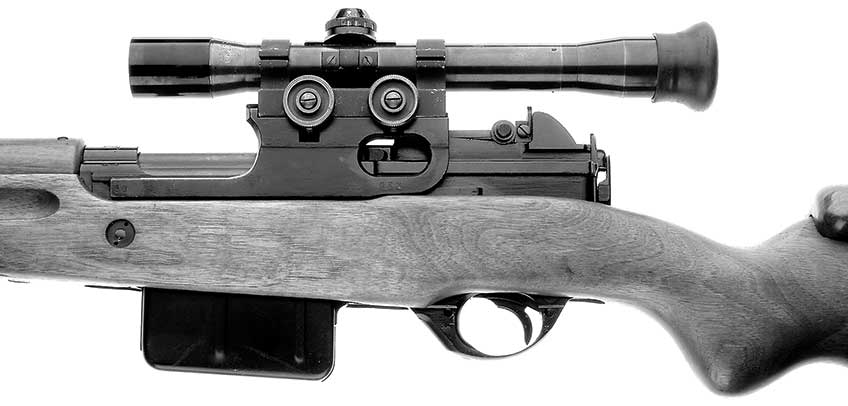
Four nations deployed FN-49 sniper rifles, and FN produced a total of 750 sniper rifles for Belgium, the Belgian Congo and Luxembourg. These rifles had a wood cheekpiece that accommodated both right- and left-handed shooters and a scope-mounting base installed in a shallow dovetail on the left side of the receiver.
Optics were selected and installed by the using nation. Belgium and Luxembourg chose a 4X scope made by OIP (Societe Belge d’Optique et d’Instuments de Precision), an optics company located in Gand, Belgium. The scope used by the Belgian Congo is unknown but may have been an OIP as well. The Egyptian army also converted a small number of its “three-swivel” variant rifles into a sniper configuration. These rifles had muzzle brakes and wood cheekpieces optimized for right-handed shooters. Egypt selected a 2.5X scope made by Meopta in Czechoslovakia. No evidence has been found to substantiate the existence of sniper rifles in any of the other five production contracts.
Customer requests prompted FN to develop a selective-fire version of the FN-49, referred to as the AFN (Auto-matique Fabrique Nationale). The AFN’s primary external characteristic was the automatic-fire lever (selector) on the left side of the trigger guard. The practicality and effectiveness of a 9½-lb., .30-’06, selective-fire rifle with a 10-round magazine capacity is open to question.
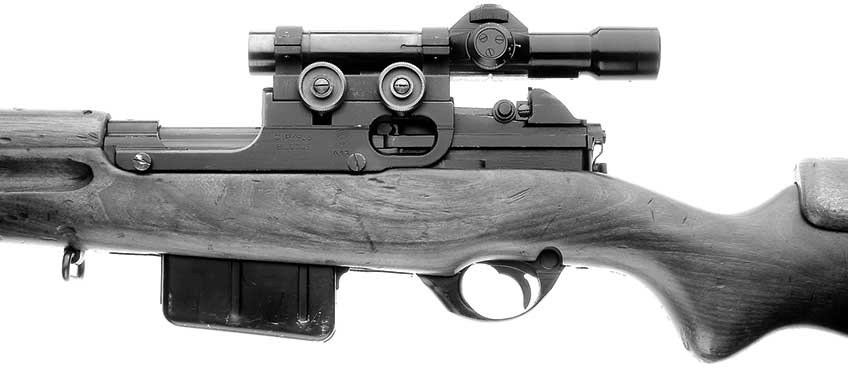
Another FN-49 variant was created when Argentina modified its FN-49s in the early 1970s to use 20-round detachable magazines and to chamber the 7.62x51 mm NATO cartridge. It used a unique magazine not based on that of the FN FAL, as is sometimes reported. The conversions were performed in Argentina by a private firm. Metalúrgica Centro, in Banfield, Buenos Aires Province, formerly known as Armas Halcón (Hawk Arms), was a well-established Argentine arms manufacturer that had designed and produced military and sporting firearms for many years.
Accessories for the rifle offered by FN included two bayonets: the Model 1949 Short Export (with a 9" double-edged blade) and the Model 1924/49 Long Export (with a 15" single-edged blade). Also offered were a muzzle brake, blank-firing adapter, gas-adjustment wrench, cleaning equipment and slings as optional equipment. A clamp-on grenade launcher made in Belgium by MECAR was also available.
The service life of the FN-49 was quite varied. Venezuela retired its FN-49s after several years of service. Belgium continued to use FN-49s in second-line service as late as 1988. Some FN-49s are said to still be in service in Argentina and Brazil as parade or drill rifles. The FN-49s did serve in combat, and the Belgians used them in the Korean conflict to good effect.

The FN-49 saw extensive combat in the Congo in the hands of Belgian, Congolese and insurgent forces. Egypt used FN-49s in action in the 1956 Suez-Sinai war against Israeli, British and French forces, and undoubtedly in later conflicts against Israel. The rifles also equipped forces serving on United Nations peacekeeping missions.
After they were withdrawn from service, most FN-49s were sold on the surplus market. The first known import to the U.S. was in 1958; these were Egyptian contract rifles that were battlefield captures from the 1956 Suez-Sinai war. Between 1965 and 1967, essentially all of the rifles of the Colombian, Luxembourg, and Venezuelan contracts were imported to the United States.
The Gun Control Act of 1968 prohibited the import of surplus military firearms until late 1984, when import of certain surplus firearms was once again allowed. The vast majority of the Egyptian contract rifles in the U.S. were imported soon thereafter. Since then, there have been two imports of the Argentine contract rifles: one in 1995 and another in 2003. There have been no quantity imports of rifles from the Belgian, the Belgian Congo, Brazilian or Indonesian contracts.
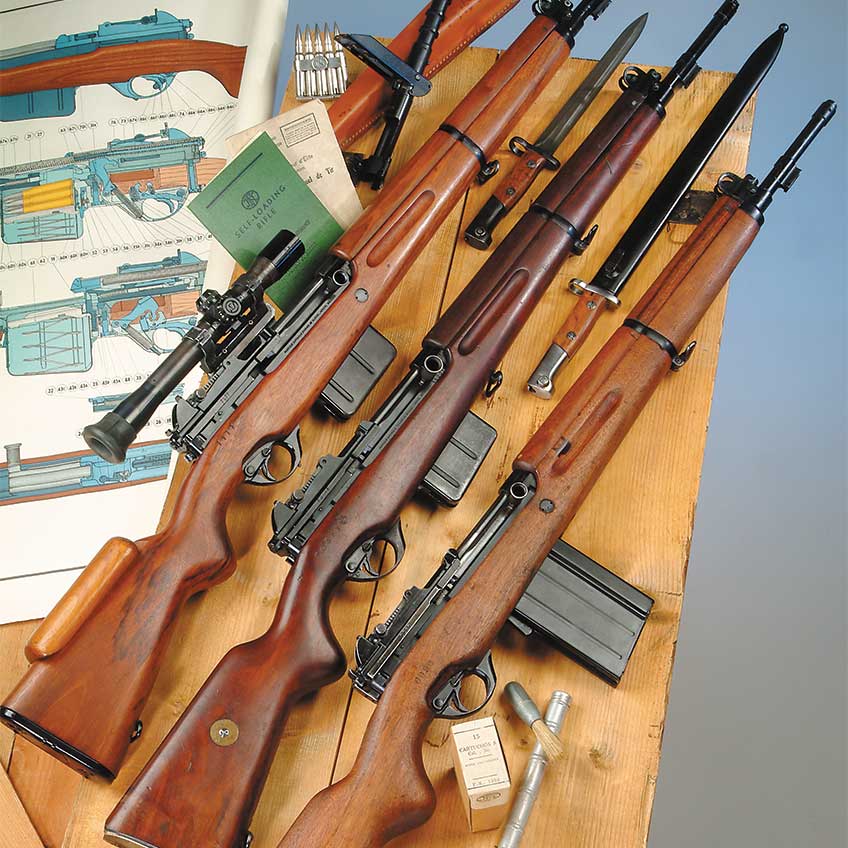
While a superbly designed and manufactured rifle, the timing of the FN-49’s introduction robbed it of the opportunity to be a great success or to achieve wider use. For most nations, it was a bridge between bolt-action service rifles and the adoption of a later generation of selective-fire rifles.
As for Dieudonne Saive and FN, the FN-49 filled a market niche and provided funds for the development of other projects. Indeed, concurrent with the development of the FN-49 in the late 1940s, Saive was also working on what would become the most widely used military self-loading rifle in the free world, the FN Fusil Automatique Léger—otherwise known as the FN FAL.
Editor's Note: Since this article's publication, another source of FN-49 rifles has emerged. Royal Tiger Imports has imported the most recent batch of FN-49 rifles, which were discovered in storage in Ethiopia. You can read about the discovery here.















